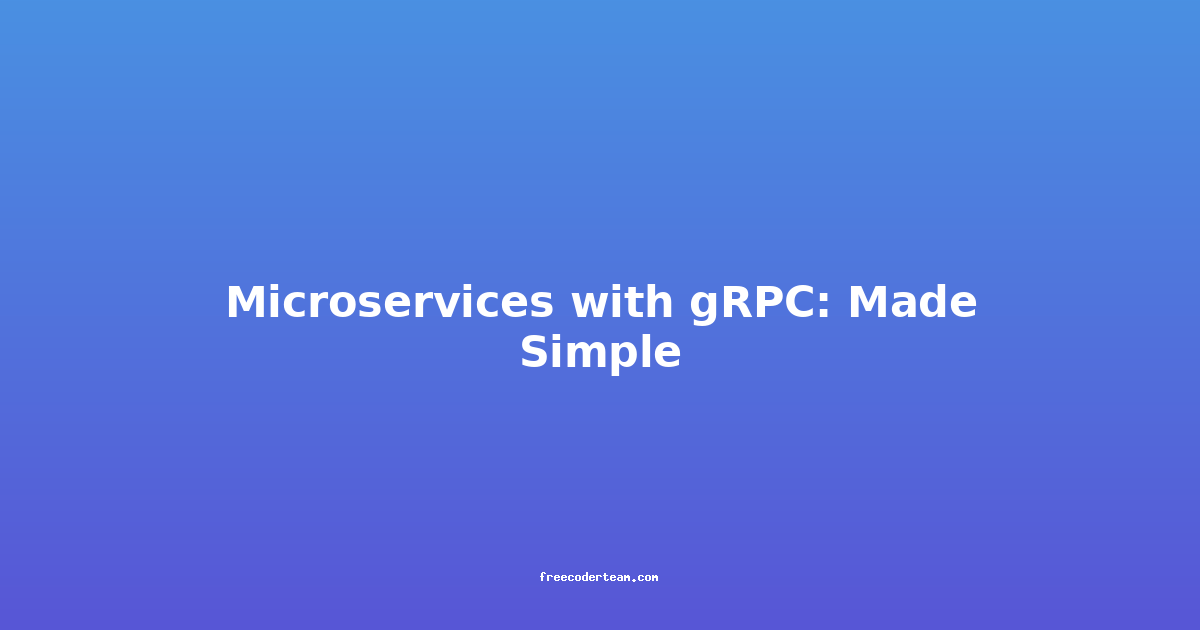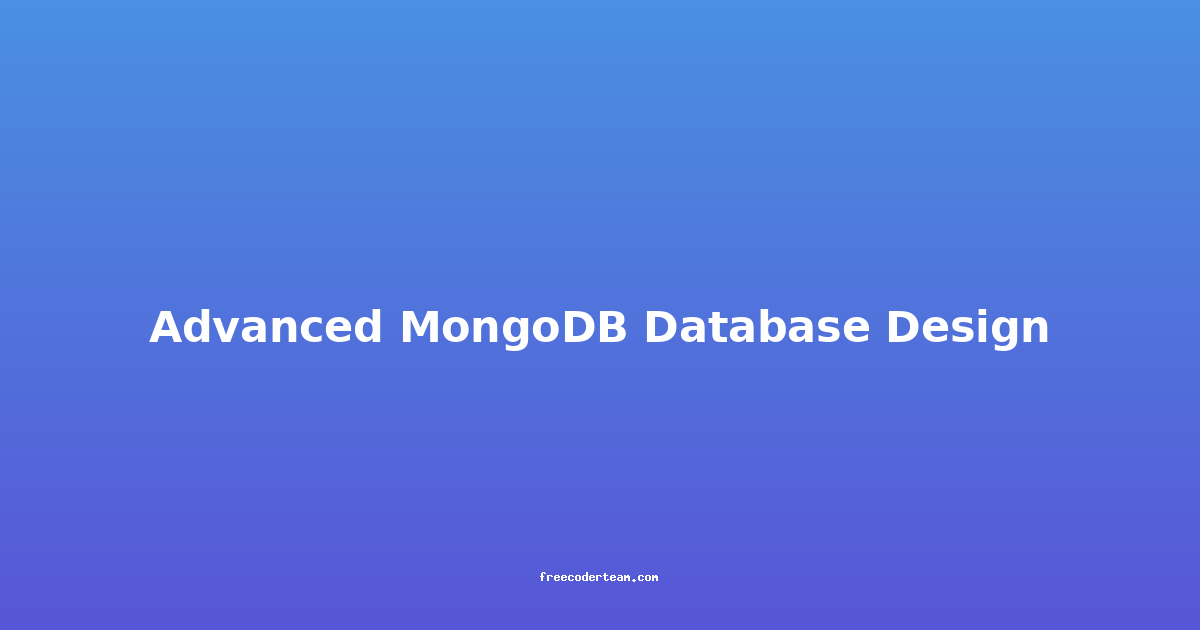Microservices with gRPC: Made Simple
In today's fast-paced software development landscape, microservices have become the de facto architecture for building scalable, modular, and maintainable applications. However, the success of microservices relies heavily on the communication protocols used between services. One such protocol that has gained immense popularity is gRPC (Google Remote Procedure Call). gRPC is a high-performance, open-source RPC framework that enables efficient communication between microservices using Protocol Buffers (Protobuf) for defining service contracts.
In this blog post, we'll explore gRPC in the context of microservices, breaking it down into practical examples, best practices, and actionable insights. By the end, you'll have a clear understanding of how to leverage gRPC to build robust and efficient microservice-based applications.
Table of Contents
- What is gRPC?
- Why Use gRPC for Microservices?
- Setting Up a gRPC Microservice
- Example: Building a Basic gRPC Service
- Best Practices for gRPC in Microservices
- Actionable Insights and Challenges
- Conclusion
What is gRPC?
gRPC is an open-source RPC framework developed by Google, designed to facilitate high-performance communication between microservices. It uses HTTP/2 as the underlying transport protocol, offering features like bidirectional streaming, flow control, and header compression. gRPC relies on Protocol Buffers (Protobuf) for defining service contracts and serializing data, ensuring efficient and language-independent communication.
Key Features of gRPC:
- HTTP/2: Supports multiplexing, bidirectional streaming, and high-performance communication.
- Protobuf: A powerful data serialization format that is efficient, language-agnostic, and extensible.
- Language Support: gRPC is available for multiple programming languages, including Go, Java, Python, Node.js, and more.
- Bidirectional Streaming: Enables real-time communication between services.
gRPC is particularly well-suited for microservices because it allows services to communicate in a structured, efficient, and scalable manner.
Why Use gRPC for Microservices?
Microservices are designed to be independent, loosely coupled, and scalable. However, the efficiency of communication between these services is crucial. gRPC offers several advantages that make it an ideal choice for microservices:
- High Performance: gRPC leverages HTTP/2 and Protobuf, resulting in lower latency and higher throughput compared to REST APIs.
- Efficient Data Serialization: Protobuf is more compact and faster than JSON, making it ideal for high-volume data exchange.
- Strong Contract Definition: Protobuf ensures clear, well-defined service contracts, reducing ambiguity and errors.
- Language Agnostic: Services can be written in different programming languages and still communicate seamlessly.
- Advanced Features: Supports bidirectional streaming, unary calls, server-side streaming, and client-side streaming.
These features make gRPC a powerful tool for building robust microservice architectures.
Setting Up a gRPC Microservice
Before diving into practical examples, let's set up the environment for building gRPC microservices. We'll use Go as the programming language for this tutorial, as it has first-class support for gRPC and Protobuf.
Prerequisites:
- Go: Installed on your system (version 1.18 or later).
- Protobuf Compiler: Install the Protobuf compiler (
protoc). - gRPC Tools: Install the Go plugin for Protobuf (
protoc-gen-go).
You can install the necessary tools using the following commands:
# Install Protobuf compiler
brew install protobuf # On macOS
sudo apt install protobuf-compiler # On Ubuntu
# Install Go plugin for Protobuf
go install google.golang.org/protobuf/cmd/protoc-gen-go@latest
go install google.golang.org/grpc/cmd/protoc-gen-go-grpc@latest
Directory Structure:
my-grpc-service/
├── proto/
│ └── greeter.proto
├── server/
│ └── server.go
├── client/
│ └── client.go
└── go.mod
Example: Building a Basic gRPC Service
Let's build a simple gRPC service called Greeter that responds with a personalized greeting.
1. Define the Service Contract (Protobuf)
Create a greeter.proto file in the proto/ directory:
syntax = "proto3";
package greeter;
service Greeter {
rpc SayHello (HelloRequest) returns (HelloReply) {}
}
message HelloRequest {
string name = 1;
}
message HelloReply {
string message = 1;
}
2. Generate gRPC Code
Run the following command to generate Go code from the Protobuf definition:
protoc --go_out=plugins=grpc:./proto --go_opt=paths=source_relative proto/greeter.proto
This command generates the necessary Go code for the Greeter service in the proto/ directory.
3. Implement the Server
Create a server.go file in the server/ directory:
package main
import (
"context"
"log"
"net"
grpc "google.golang.org/grpc"
pb "github.com/yourusername/my-grpc-service/proto"
)
type server struct {
pb.UnimplementedGreeterServer
}
func (s *server) SayHello(ctx context.Context, req *pb.HelloRequest) (*pb.HelloReply, error) {
return &pb.HelloReply{Message: "Hello, " + req.Name}, nil
}
func main() {
lis, err := net.Listen("tcp", ":50051")
if err != nil {
log.Fatalf("failed to listen: %v", err)
}
defer lis.Close()
s := grpc.NewServer()
pb.RegisterGreeterServer(s, &server{})
log.Printf("Server listening at %v", lis.Addr())
if err := s.Serve(lis); err != nil {
log.Fatalf("failed to serve: %v", err)
}
}
4. Implement the Client
Create a client.go file in the client/ directory:
package main
import (
"context"
"log"
grpc "google.golang.org/grpc"
pb "github.com/yourusername/my-grpc-service/proto"
)
func main() {
conn, err := grpc.Dial("localhost:50051", grpc.WithInsecure())
if err != nil {
log.Fatalf("failed to connect: %v", err)
}
defer conn.Close()
client := pb.NewGreeterClient(conn)
resp, err := client.SayHello(context.Background(), &pb.HelloRequest{Name: "Alice"})
if err != nil {
log.Fatalf("failed to greet: %v", err)
}
log.Printf("Response from server: %s", resp.Message)
}
5. Run the Server and Client
Start the server:
go run server/server.go
Run the client:
go run client/client.go
You should see the output:
Response from server: Hello, Alice
Best Practices for gRPC in Microservices
To maximize the benefits of gRPC in microservices, follow these best practices:
1. Use Protobuf for Strong Contracts
- Define clear and versioned Protobuf schemas.
- Use consistent naming conventions for messages and services.
- Avoid breaking changes in Protobuf definitions by using versioning.
2. Leverage HTTP/2 Features
- Use bidirectional streaming for real-time communication.
- Take advantage of HTTP/2's multiplexing for efficient resource utilization.
3. Implement Client-Side Load Balancing
- Use load balancers like Envoy or Kubernetes to distribute traffic across gRPC servers.
- Implement circuit breakers and retries to handle failures gracefully.
4. Use gRPC Metadata for Contextual Information
- Pass metadata like authentication tokens, request IDs, and tracing headers using gRPC metadata.
5. Monitor and Debug gRPC Services
- Use tools like gRPC-Web for debugging.
- Implement logging and metrics to monitor gRPC traffic and performance.
Actionable Insights and Challenges
Insights:
- Efficiency: gRPC is significantly faster than REST APIs due to Protobuf's compact serialization.
- Scalability: gRPC's support for bidirectional streaming and HTTP/2 makes it ideal for scalable microservices.
- Cross-Language Compatibility: gRPC supports multiple languages, enabling polyglot microservice architectures.
Challenges:
- Learning Curve: Developers need to learn Protobuf and gRPC concepts.
- Debugging: Debugging gRPC services can be more complex than REST APIs.
- Tooling: While gRPC has strong tooling, it may lack some ecosystem support compared to REST.
Conclusion
gRPC is a powerful tool for building efficient and scalable microservices. Its combination of HTTP/2, Protobuf, and language-agnostic communication makes it an excellent choice for modern application architectures. By following best practices and leveraging gRPC's advanced features, developers can build robust and performant microservice-based applications.
In this blog post, we explored the fundamentals of gRPC, set up a basic gRPC service, and discussed best practices and actionable insights. Whether you're building a new microservice application or migrating from REST, gRPC offers a compelling alternative for efficient service-to-service communication.
Feel free to experiment with gRPC in your projects and explore its potential for enhancing your microservice architecture!
Resources:
I hope this post has provided a comprehensive understanding of gRPC and its application in microservices. Happy coding! 🚀




